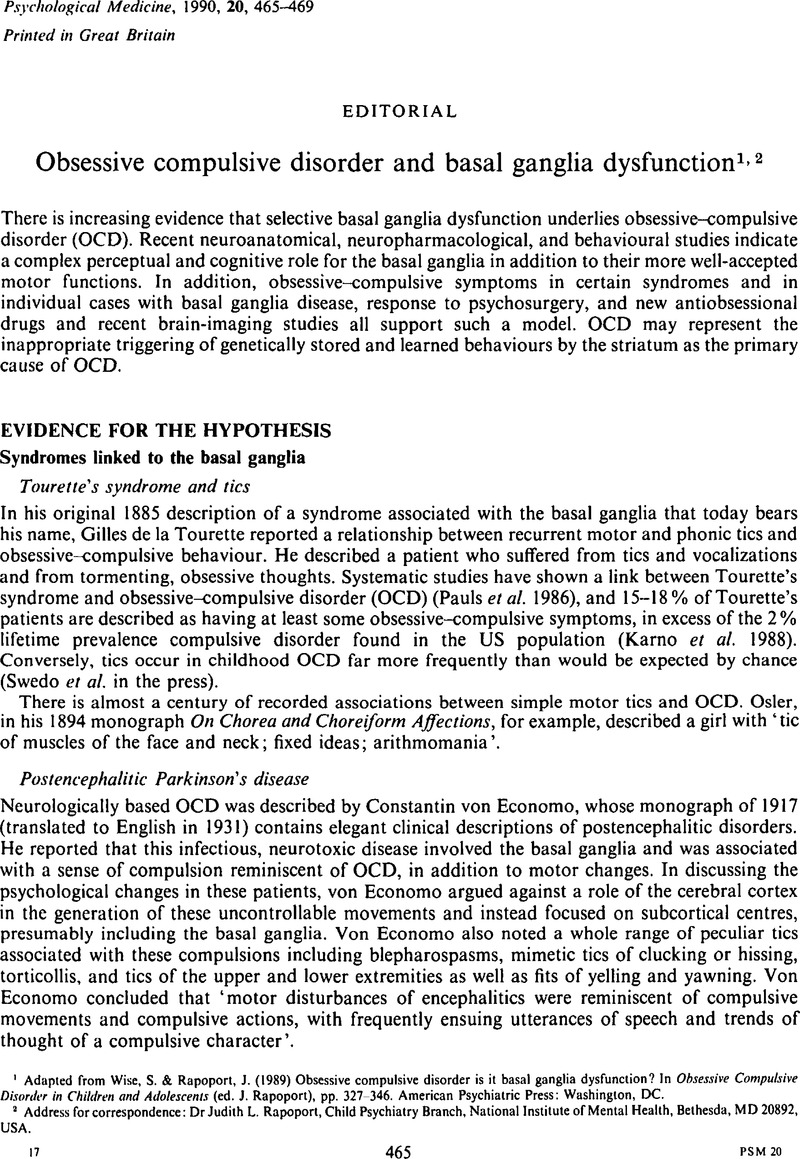Crossref Citations
This article has been cited by the following publications. This list is generated based on data provided by Crossref.
Voeller, Kytja K.S.
1991.
Toward a Neurobiologic Nosology of Attention Deficit Hyperactivity Disorder.
Journal of Child Neurology,
Vol. 6,
Issue. 1_suppl,
p.
S2.
Pantelis, Christos
Barnes, Thomas R. E.
and
Nelson, Hazel E.
1992.
Is the Concept of Frontal–Subcortical Dementia Relevant to Schizophrenia?.
British Journal of Psychiatry,
Vol. 160,
Issue. 4,
p.
442.
Tallis, Frank
and
de Silva, Padmal
1992.
Worry and obsessional symptoms: A correlational analysis.
Behaviour Research and Therapy,
Vol. 30,
Issue. 2,
p.
103.
Eggers, Christian
Schepker, Renate
and
Oades, Robert
1993.
Case report: Exacerbation and provocation of tics by imipramine and sulpiride.
European Child & Adolescent Psychiatry,
Vol. 2,
Issue. 3,
p.
169.
Hay, P.
Sachdev, P.
Cumming, S.
Smith, J. S.
Lee, T.
Kitchener, P.
and
Matheson, J.
1993.
Treatment of obsessive‐compulsive disorder by psychosurgery.
Acta Psychiatrica Scandinavica,
Vol. 87,
Issue. 3,
p.
197.
Lucey, J.V.
1994.
BAP/SKB Young Psychopharmacologist Award Towards a neuroendocrinology of obsessive-compulsive disorder.
Journal of Psychopharmacology,
Vol. 8,
Issue. 4,
p.
250.
Vincent, Annick
Baruch, Philippe
Pourcher, Emmanuelle
and
Vincent, Pierre
1994.
Implication Des Noyaux Gris Centraux Dans Le Trouble Obsessionnel-Compulsif: Une Revue.
The Canadian Journal of Psychiatry,
Vol. 39,
Issue. 9,
p.
545.
Harris, Gordon J.
Hoehn‐Saric, Rudolf
Lewis, Robert
Pearlson, Godfrey D.
and
Streeter, Chris
1994.
Mapping of SPECT regional cerebral perfusion abnormalities in obsessive‐compulsive disorder.
Human Brain Mapping,
Vol. 1,
Issue. 4,
p.
237.
Rachlin, Howard
1995.
Self-control: Beyond commitment.
Behavioral and Brain Sciences,
Vol. 18,
Issue. 1,
p.
109.
Fantino, Edmund
1995.
The future is uncertain: Eat dessert first.
Behavioral and Brain Sciences,
Vol. 18,
Issue. 1,
p.
125.
Mele, Alfred
1995.
Conceptualizing self-control.
Behavioral and Brain Sciences,
Vol. 18,
Issue. 1,
p.
136.
Baum, William M.
1995.
Patterns yes, agency no.
Behavioral and Brain Sciences,
Vol. 18,
Issue. 1,
p.
122.
Killeen, Peter R.
1995.
The future of an illusion: Self and its control.
Behavioral and Brain Sciences,
Vol. 18,
Issue. 1,
p.
133.
Kanekar, Suresh
1995.
Conceptual problems in the act-versus-pattern analysis of self-control.
Behavioral and Brain Sciences,
Vol. 18,
Issue. 1,
p.
132.
Hocutt, Max
1995.
Self-control as habit.
Behavioral and Brain Sciences,
Vol. 18,
Issue. 1,
p.
129.
Eisenberger, Robert
1995.
Does behaviorism explain self-control?.
Behavioral and Brain Sciences,
Vol. 18,
Issue. 1,
p.
125.
Hineline, Philip N.
1995.
The extended psychological present.
Behavioral and Brain Sciences,
Vol. 18,
Issue. 1,
p.
128.
Smith, Terry L.
1995.
Alternatives to radical behaviorism.
Behavioral and Brain Sciences,
Vol. 18,
Issue. 1,
p.
143.
Schirillo, James A.
1995.
Self-control: Acts of free will.
Behavioral and Brain Sciences,
Vol. 18,
Issue. 1,
p.
141.
Frank, Robert H.
1995.
Internal commitment and efficient habit formation.
Behavioral and Brain Sciences,
Vol. 18,
Issue. 1,
p.
127.





